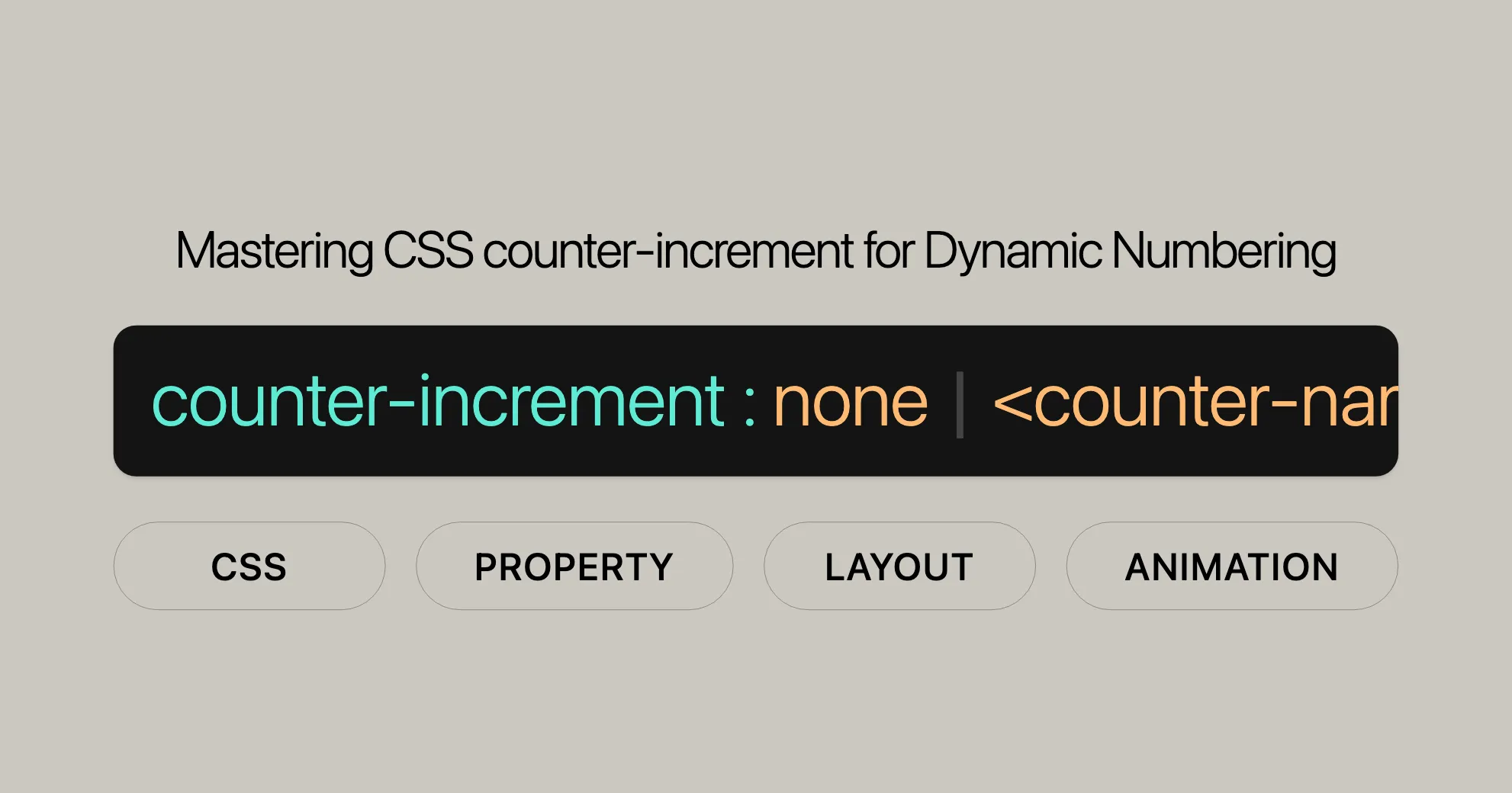- Services
- Case Studies
- Technologies
- NextJs development
- Flutter development
- NodeJs development
- ReactJs development
- About
- Contact
- Tools
- Blogs
- FAQ
Mastering CSS counter-increment for Dynamic Numbering
This property allows you to increment or decrement counters by specified values, providing flexible options for web design.

Introduction
The counter-increment CSS property is used to increase or decrease the value of named CSS counters. If a counter doesn’t exist, it will be created. If no value is provided, the counter will be increased by 1. This property is great for creating automatic numbering systems, like lists or headings, without needing JavaScript.
Syntax
The syntax for counter-increment is straightforward:
counter-increment: none | [ <counter-name> [ <integer> ]? ]+ | initial | inherit | revert | revert-layer | unset;Explanation
- none: Prevents any counters from being incremented or decremented.
- [ <counter-name> [ <integer> ]? ]+: Specifies one or more counters to increment or decrement. If an integer value is provided, the counter will be incremented or decremented by that amount.
- initial: Sets the property to its default value.
- inherit: Inherits the value from the parent element.
- revert: Rolls back the value to the user-agent stylesheet value.
- revert-layer: Rolls back the value to the value of the next outer CSS layer’s cascade origin.
- unset: Resets the property to its inherited value if it inherits, or to its initial value if not.
Examples
Decreasing the Counter Value
In this example, we display numbers counting backward from 100, decreasing by 7 each time.
<div> <i></i><i></i><i></i><i></i><i></i><i></i><i></i> <i></i><i></i><i></i><i></i ><i></i><i></i><i></i> <i></i><i></i><i></i><i></i><i></i><i></i><i></i> <i></i><i></i><i></i><i></i><i></i><i></i><i></i></div>div { counter-reset: sevens 100;}i { counter-increment: sevens -7;}i:first-of-type { counter-increment: none;}i::before { content: counter(sevens);}
div { display: flex; flex-direction: column; flex-wrap: wrap; height: 300px; width: 200px;}i { flex: 0 0 2em;}Increasing the Counter Value
In this example, we create a simple numbered list, incrementing the counter by 1 for each list item.
<ul> <li>Item 1</li> <li>Item 2</li> <li>Item 3</li> <li>Item 4</li></ul>ul { counter-reset: item;}li { counter-increment: item;}li::before { content: counter(item) ". ";}Using Multiple Counters
In this example, we use multiple counters to create a nested numbering system for sections and sub-sections.
<div class="multiple-counter"> <h4>Section 1</h4> <p>Item 1.1</p> <p>Item 1.2</p> <h4>Section 2</h4> <p>Item 2.1</p> <p>Item 2.2</p></div>.multiple-counter { counter-reset: main-counter;}.multiple-counter h4 { counter-reset: sub-counter;}.multiple-counter h4::before { counter-increment: main-counter; content: "Section " counter(main-counter) ". ";}.multiple-counter p::before { counter-increment: sub-counter; content: counter(main-counter) "." counter(sub-counter) " ";}Browser Support
The counter-increment property is widely supported across modern web browsers:
- Google Chrome: Supported since version 4.0.
- Firefox: Supported since version 2.0.
- Internet Explorer/Edge: Supported since version 8.0.
- Opera: Supported since version 9.6.
- Safari: Supported since version 3.1.
Specifications
The counter-increment property is defined in the CSS Lists and Counters Module Level 3. This module specifies the behavior and syntax for CSS counters.
Key Points from the Specification
- Incrementing and Decrementing Counters: You can specify how counters should be incremented or decremented.
- Creating Counters: If a named counter doesn’t exist, it will be created.
- Resetting Counters: The
counter-resetproperty can reset a counter to a specified integer value. - Global Values: The property supports global values like
initial,inherit,revert,revert-layer, andunset.
See Also
To learn more about CSS counters and related properties, explore these resources:
-
Counter Properties:
counter-set: Sets the value of one or more counters.counter-reset: Resets the value of one or more counters.
-
Counter At-Rule:
@counter-style: Defines custom counter styles for more control over their appearance.
-
Counter Functions:
counter(): Displays the value of a counter.counters(): Displays nested counters.
-
Guides and Modules:
- Using CSS Counters: A comprehensive guide on using CSS counters effectively.
- CSS Lists and Counters: Covers the specifications for CSS lists and counters, including the
counter-incrementproperty. - CSS Counter Styles: Provides information on different styles that can be applied to counters.
 สร้างเว็บไซต์ 1 เว็บ ต้องใช้งบเท่าไหร่? เจาะลึกทุกองค์ประกอบ website development cost อยากสร้างเว็บไซต์แต่ไม่มั่นใจในเรื่องของงบประมาณ อ่านสรุปเจาะลึกตั้งแต่ดีไซน์, ฟังก์ชัน และการดูแล พร้อมตัวอย่างงบจริงจาก Till it’s done ที่แผนชัด งบไม่บานปลายแน่นอน
สร้างเว็บไซต์ 1 เว็บ ต้องใช้งบเท่าไหร่? เจาะลึกทุกองค์ประกอบ website development cost อยากสร้างเว็บไซต์แต่ไม่มั่นใจในเรื่องของงบประมาณ อ่านสรุปเจาะลึกตั้งแต่ดีไซน์, ฟังก์ชัน และการดูแล พร้อมตัวอย่างงบจริงจาก Till it’s done ที่แผนชัด งบไม่บานปลายแน่นอน  Next.js สอน 14 ขั้นตอนเบื้องต้น: สร้างโปรเจกต์แรกใน 30 นาที เริ่มต้นกับ Next.js ใน 14 ขั้นตอนเพียงแค่ 30 นาที พร้อม SSR/SSG และ API Routes ด้วยตัวอย่างโค้ดง่าย ๆ อ่านต่อเพื่อสร้างโปรเจ็กต์แรกได้ทันทีที่นี่
Next.js สอน 14 ขั้นตอนเบื้องต้น: สร้างโปรเจกต์แรกใน 30 นาที เริ่มต้นกับ Next.js ใน 14 ขั้นตอนเพียงแค่ 30 นาที พร้อม SSR/SSG และ API Routes ด้วยตัวอย่างโค้ดง่าย ๆ อ่านต่อเพื่อสร้างโปรเจ็กต์แรกได้ทันทีที่นี่  วิธีสมัคร Apple Developer Account เพื่อนำแอปขึ้น App Store ทีละขั้นตอน อยากปล่อยแอปบน App Store ระดับโลก มาอ่านคู่มือสมัคร Apple Developer Account พร้อมเคล็ดลับ TestFlight และวิธีอัปโหลดที่ง่ายในบทความเดียวนี้ได้เลย
วิธีสมัคร Apple Developer Account เพื่อนำแอปขึ้น App Store ทีละขั้นตอน อยากปล่อยแอปบน App Store ระดับโลก มาอ่านคู่มือสมัคร Apple Developer Account พร้อมเคล็ดลับ TestFlight และวิธีอัปโหลดที่ง่ายในบทความเดียวนี้ได้เลย  TypeScript Interface คืออะไร? อธิบายพร้อมวิธีใช้และข้อแตกต่างจาก Type เรียนรู้วิธีใช้ TypeScript Interface เพื่อสร้างโครงสร้างข้อมูลที่ปลอดภัยและเข้าใจง่าย พร้อมเปรียบเทียบข้อดีข้อแตกต่างกับ Type ที่คุณต้องรู้ ถูกรวมเอาไว้ในบทความนี้แล้ว
TypeScript Interface คืออะไร? อธิบายพร้อมวิธีใช้และข้อแตกต่างจาก Type เรียนรู้วิธีใช้ TypeScript Interface เพื่อสร้างโครงสร้างข้อมูลที่ปลอดภัยและเข้าใจง่าย พร้อมเปรียบเทียบข้อดีข้อแตกต่างกับ Type ที่คุณต้องรู้ ถูกรวมเอาไว้ในบทความนี้แล้ว  Material-UI (MUI) คืออะไร อยากสร้าง UI สวยงามและเป็นมืออาชีพในเวลาอันรวดเร็วใช่ไหม มาทำความรู้จักกับ Material-UI (MUI) ที่ช่วยให้คุณพัฒนาแอปพลิเคชันบน React ได้ง่ายและดูดีในทุกอุปกรณ์
Material-UI (MUI) คืออะไร อยากสร้าง UI สวยงามและเป็นมืออาชีพในเวลาอันรวดเร็วใช่ไหม มาทำความรู้จักกับ Material-UI (MUI) ที่ช่วยให้คุณพัฒนาแอปพลิเคชันบน React ได้ง่ายและดูดีในทุกอุปกรณ์  เปรียบเทียบ 3 วิธีติดตั้ง install node js บน Ubuntu: NVM vs NodeSource vs Official Repo แบบไหนดีที่สุด? เรียนรู้วิธีติดตั้ง Node.js บน Ubuntu ด้วย NVM, NodeSource หรือ Official Repo เลือกวิธีที่เหมาะกับความต้องการของคุณ พร้อมเปรียบเทียบ เพื่อการพัฒนาที่มีประสิทธิภาพ!
เปรียบเทียบ 3 วิธีติดตั้ง install node js บน Ubuntu: NVM vs NodeSource vs Official Repo แบบไหนดีที่สุด? เรียนรู้วิธีติดตั้ง Node.js บน Ubuntu ด้วย NVM, NodeSource หรือ Official Repo เลือกวิธีที่เหมาะกับความต้องการของคุณ พร้อมเปรียบเทียบ เพื่อการพัฒนาที่มีประสิทธิภาพ! Talk with CEO
We'll be right here with you every step of the way.
We'll be here, prepared to commence this promising collaboration.
Whether you're curious about features, warranties, or shopping policies, we provide comprehensive answers to assist you.


